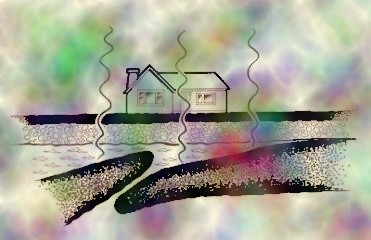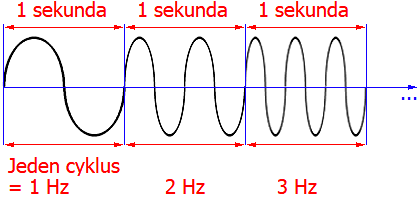Frequencies and GPZ
Geopathic Zones and Their Impact on Health
The word "geopathic" originates from two Greek words: geo = earth, pathos = suffering, disease. Freely translated, it means suffering that comes from the earth, or a disease originating from the earth.

A geopathic zone is understood as a part of space loaded with a certain kind of frequency or radiation. Examples include electromagnetic radiation, radon, various transmitters, radar, X-rays, magnetic fields, gamma radiation, ultrasound, infrasound, microwaves, and gravitational vibrations in areas with moving masses, tectonic faults, and underground streams - the flow of water underground creates negative frequencies (noise, infrasound) for humans. Other geopathic zones include cosmic radiation, Hartmann grid, and Curry grid or bands.
Where geopathic zones intersect, their effects are intensified and multiplied.

A house built on a GPZ is also called a "cancer house."
The first mentions of geopathic zones (dragon veins) are over 4000 years old and come from China. Emperor Kuang Yü issued a decree on the study of "dragon veins" and water streams on plots designated for construction. He established the office of a geomancer (dowser), who had to check the presence of GPZ on the site to determine if construction could proceed. Construction could only begin once approved by the geomancer.

In the former Czechoslovakia, official attention was paid to GPZ in 1964-1965 by Mr. Juryška, an oncologist from Olomouc, and Mr. Galdavský, an architect. They were part of the building approval process based on GPZ. There was also an analysis by Galdavský and Juryška about the underground branch of the Morava River and its impact on health and the increased incidence of cancer in the area. After 1968, this work, research, and practice had to be forgotten.
For the creation of sound, two factors are important: the source and the environment. The source is a body producing mechanical waves that travel through the environment, such as air or water. Each sound wave travels in regular frequencies, or repetitions. The unit of frequency is called hertz (Hz), which indicates how many such waves repeat in one second.

The perception of the sound depends on its frequency – whether we can hear it or not. Sound waves that the human ear can detect range from 20 to 20,000 Hz (some sources state that the threshold of audibility starts at 16 Hz). Sound travels at certain frequencies measured in hertz. In contrast, infrasound has a much lower frequency range, from 0.1 to 20 Hz (the lowest value cannot be zero, as it is assumed that some minimal sound always propagates).
LucMahler - Pinterest

Ultrasound frequencies, on the opposite end of the spectrum, are much higher, ranging from 20,000 hertz upwards.
LucMahler - Pinterest

Although humans cannot hear infrasound, its use is quite common in nature. For example, elephants create infrasound waves that travel through the ground for hundreds of kilometers, used for communication. Giraffes and whales also use infrasound.
MissyWhimsyArt - Pinterest

Infrasound is also associated with natural phenomena such as earthquakes, strong sea waves, and volcanic activity. Artificial sources of infrasound include engines, airplanes, nuclear and chemical expolsions.
Mohamed_hassan - Pinterest

Regarding risks, infrasound values are close to brain alpha waves. In humans, infrasound effects can manifest as headaches, nausea, fatigue, and general physical and psychological discomfort. Extreme values can even cause hearing loss.

Ultrasound poses much lower biological risks, as evidenced by its use in medicine, where ultrasound frequencies range from 2 to 18 MHz.
Dogs have historically been indicators of geopathic zones. The best place to put a bed is where a dog chooses to sleep. A dog cannot sleep where it is disturbed by infrasound, which reminds it of growling. Dogs have very well-developed hearing, guided by the autonomic nervous system, and can hear lower frequencies and perceive subtle disturbances.
Emolago - Pinterest

Cats are the opposite of dogs. When content, they purr. Vibrations from the "trapdoor" in the oral cavity create a tone similar to infrasound, which vibrates through their entire body. Thus, cats seek out places that remind them of this sound, including infrasound geopathic zones. Therefore, we do not place beds, rest areas, or workstations where cats like to rest.
Iffany - Pinterest

Bees also produce more honey in infrasound geopathic zones because infrasound keeps them active. The noises sound like their own buzzing, produced by their wings during daily activity. Placing hives in suitable geopathic zones aids the quality of the bee colonies.
Myshoun - Pinterest

Similarly, ants thrive in GPZ, as they produce sounds similar to infrasound. Locations of ant nests often coincide with GPZ. Monitoring how nature and domestic animals respond to geopathic zones is very important.
Souandresantana - Pinterest

Impact of Geopathic Zones on Humans
Young children are very sensitive and will always seek a place in their cribs to avoid these zones. If they cannot avoid them, they sleep restlessly. Because infrasound and radiation come from the earth's interior, prolonged exposure negatively affects humans. It usually manifests as a disease in the weakest organ of the body. This process can be accelerated by a genetic predisposition. Short-term exposure to these zones causes concentration disorders or feelings of oppression and unexplained fatigue in sensitive individuals. Long-term exposure, such as nightly sleep in a geopathic zone, can trigger a range of illnesses, from minor to severe, usually in combination with other factors. According to many scientists involved in natural medicine, respecting GPZ is part of active health prevention.
NickyPe- Pinterest




